#105: Easternal
Yeah, I don’t really know what Easternal means either, I just needed another title to key into the fact that today is apparently Easter, one of those shifting around holidays that insist on confounding by jumping about the calendar every year. I’m used to Easter being an April thing, but this year apparently it snuck in at the very end of March. I would imagine that we have both celebrants and non-celebrants following this feature, so whichever side of this divide you happen to fall on, I hope you have a chocolatey day calibrated to your personal belief preferences.
Once again this past week, we pulled in a lot of questions, so I’m just going to plow ahead and attempt to knock them all down. Let’s see how I make out here.
Callie
Question: Who oversees cancellations? In the current age of Marvel where series' other than flagship titles like Avengers, X-Men, and Spider-Man are lucky to get more than 10 issues, how are those types of decisions made? Is it the editor who decides? Is it the editor's job to say "this series might get more sales if we cancel it, then bring it back with the same creative team at issue 1," or is there someone else who makes that call? And how do you personally feel about this current state? Do you think that runs that last for a long time, or at least keep legacy numbering as their main number are worse because it's harder for new people to jump on? I hear a lot of fans arguing that those types of easy jumping on points are also easy jumping off points for people who have read for a while and have no interest in supporting a book that feels like it's doing its writers and readers so dirty.
Well, Callie, it’s a combination of the Publisher, the Head of Sales and the Editor in Chief who typically determine whether a title gets the axe or not. And those that do usually do so because their sales have drifted downward to the point where they aren’t bringing in the necessary revenue margin to contribute to the company’s overhead. As I like to say when fans complain about the demise of a series, it’s always easiest to spend somebody' else’s money. So while, sure, I prefer a world of stability where books can run indefinitely, we actually need for there to be enough readers to allow for that, and that tends to be a difficult thing to maintain on books that aren’t the bedrock perennials—and even those require a refresh every now and again in order to keep things going. And fans can argue about jump-off points all that they like, but the tangible evidence in terms of dollar spent is indisputably behind the notion that more readers and more retailers are likely to begin a series at a #1 than at a #15 or #67 or #854. We might wish it different, but that’s what the people do rather than what they say.
Pluto
Question: As a long time X-men fan, I'm excited to see what's in store for the mutants' future under your leadership. I noticed that there were 6 other books announced, but I can't seem to find the creative teams to decided whether or not I'll be buying. Is that not announced yet? If so, when can we expect more information on these titles?
Glad to hear that you’re interested, Pluto. We haven’t yet said anything about those other books, in large part because all of this is still a number of months off, and I don’t think it would be square to pull attention so sharply from the end of the Krakoa era that’s playing out now. But as time goes on, you’ll begin to get more and more of the information you’re after. And the first thing that you’ll actually be able to see and read will be the story in this year’s Free Comic Book Day release, which’ll be in stores the first Saturday in May. So just over a month away now.
X of Alex
Looking at those Avengers Retreat Notes from '09, I can gleam that JMS was not present at the gathering, and that one Kieron Gillen--who would take over Thor before the year was over--isn't even mentioned. Could you describe what the JMS-Gillen handover of Thor entailed, and how Siege factored into it? One imagines a haphazard, tumultuous affair.
It was a bit that, Alex, but no more so than it often is. I don’t remember exactly why JMS wasn’t at that Retreat—he was invited to it as he had been the prior ones, but he had some conflict that made his presence impossible. Which was unfortunate, as he definitely hoped to keep his THOR run separate from the rest of the Marvel Universe for a while longer. But everybody had been clear for some time that the character and the series was going to reach a point where it would need to be integrated again sooner or later—and this was felt overall to be the best moment. Accordingly, JMS recused himself from THOR once everything got ratified, and so we were then in the market for another writer. Matt Fraction and Pasqual Ferry were going to take over the book, but due to scheduling conflicts, they weren’t going to be able to do so immediately, there was going to be a gap of time that needed to be filled in. Additionally, JMS had left a number of subplots dangling when he left the title, so those needed to be cleaned up as well. I believe that it was THOR editor Warren Simons who pushed for Kieron to take over the title in the interim. At the time, Kieron hadn’t done all that much for Marvel, but Warren had been using him on a couple of THOR-related one-shots and felt like he had the goods to handle the assignment. Turned out that he was right, and Kieron’s string of issues were well-received and sold well. So much so that the decision was made to continue the numbering on into a revived JOURNEY INTO MYSTERY series starring Loki, which is really where Kieron became a force.
Jeff Ryan
As someone who cares and thinks about covers, and there any classic Marvel covers where your eye sees things that could be better? Switch out inker A for inker B, move a starburst, go easier/heavier on the yellow, etc?
Sure, Jeff, all the time. In fact, there’s a whole section of my website here that’s all about classic covers, good and bad. That said, it’s also way easier to Monday morning quarterback on these sorts of situations, so take everything with a grain of salt please.
Stuart Perks
I am looking forward to the new era of x-men and was going to ask why choose Idie Okonkwo as a team member but instead I was wondering about all the characters featured on the new champions variant covers, some of whom will soon be appearing in Spider-woman. Using these as an example, what is it about a new character that piques your interest and would either make you want to read about them or feature them in a comic ?
In terms of Idie, Stuart, she was quite simply a character that incoming writer Jed MacKay was interested in using, though we both agreed that she could use a more super hero-sounding code name than Oya, which doesn’t seem like a word that could ever be a successful logo. In terms of new characters like the New Champions, the marketplace goes through period where readers and retailers suddenly get really excited about new characters and what they might grow into over time. So we’ll occasionally do something like those New Champions covers simply to test the waters and see if anything throws up sparks as has happened in the past. I tend to feel like comics should always have new characters showing up in them.
Craig Byrne
Just one question this week: X-MEN Legacy # will be 302? When did 301 come out?
My bad, Craig, it’ll be #301. Mistyped and didn’t catch it in time.
Ducc
Hi Tom, hope you're having a great day. You're misremembering that part about Deadpool not appearing in those last issues, it was actually Cable that stopped appearing due to his apparent death in X-Men #200 (which also resulted in him getting written out of the comic in Issue #42 at the same time). The title would continue on as a Deadpool team-up book till its end.
Now that's out of the way, here is my question: Who are in charge of managing the legacy numberings? Because the legacy numbering of Adjectiveless X-Men you're guys are going with does not look right at all. I also wrote about it under Julian's comment in the last newsletter but to recap: you can't use X-Men Vol 2's numbering since the title would become X-Men Legacy and go on until Issue #275 before being relaunched and go on for another 24 issues before then ending on X-Men Legacy #300. Adjectiveless X-Men would also get relaunched twice during the time Legacy was being published as its own separate title. This new legacy numbering you guys are going with not only just disregards that (and is also wrong, since the next legacy issue would be #301 and not #302), but also opens up another problem: What happens to the 67 issues that were published at the same time X-Men Legacy was going? Which legacy numbering do they account for?
You’re correct about Cable being the one to make an early departure from CABLE AND DEADPOOL, Ducc, thanks. In terms of your question about Legacy numbering, in the way that we calculate these things, you can’t really have two concurrent series both continuing the same numbering. So if there is a conflict, a choice has to be made at some point—and that choice was made when the last issue of X-MEN LEGACY went out as #300.Stuff like this is why we keep elaborate spreadsheets concerning the Legacy numbers and try to check and re-check them as we go. And we still foul things up pretty regularly.
Xavi
I know the main goal of From the Ashes must be to attract new readers, but does your Office have something in mind to avoid alieniating those who fell in love with the Krakoan era?
We’re going to do a bunch of good comics, Xavi. That’s the only way to attract and enthrall any readers, new or established. We’re going to make you want to read them by making you want to read them.
Joe West
I’m not sure how far ahead these things are talked about, but are there any big plans for Quicksilver beyond Blood Hunt? It is of course his 60th anniversary this year along with his sister’s, but while Wanda has a new ongoing set to kick off in June, Quicksilver will only have the three Avengers Blood Hunt tie-ins he will guest-star in (as far as we know). I know the Avengers will no longer be your responsibility, but are you privy to anything exciting coming his way (I don’t expect details of course).
As you say, Joe, not really my area any longer, so even if I knew something, I wouldn’t be able to tell you about it. But you can rest slightly easier knowing that editor Alanna Smith is a huge Pietro fan, and so it seems likely that she’ll be looking for opportunities to feature him again as time goes on.
Alex Dee
You mentioned before you might ship more than 12 issues a month of some of the new X-books - is that still in the cards? And if so, are you looking to do it regularly or more on an ad-hoc basis?
It is, Alex, yes. Before the editorial switch-over, Jordan White had been planning to have the two main X-MEN books ship 18 issues a year, and that plan sounded wise to me, so we’ll be keeping it in place. X-MEN and UNCANNY will alternate in this regard, with two issues on sale every other month in rotation.
JV
When was Marvel out of the red financially? Was it the first Spidey movie in 2002? What brought in enough $ to bring Marvel back into good financial health? And in a related question - when did the staff feel that things were stable? (same time as question 1 or maybe before/after - say when JoeQ got the job)?
I’m honestly not sure exactly when Marvel was completely out from under the Chapter 11 protections, JV, but I’m sure that you could research that easily enough online. And as far as the staff feeling like there was stability, I’m sure that you’d get a different answer if you spoke to a bunch of different people who were on staff in those days. But it would have been after Joe Q became EIC but also definitely at some point during his tenure.
Andres Felipe Galindo Olarte
Are there any talks with the editors of Ultimate X-men related to what they work on? Or do they have free rein to use the characters in whatever way they see fit in their “Ultimate bubble”? On that note, Have you read Ultimate X-men (or any other Ultimate book from the new line)? If so, what are your thoughts on them?
You’re giving me an opportunity to talk about how much I love Peach’s ULTIMATE X-MEN, Andres, so thanks for that. But as with the other ULTIMATE books, there isn’t really any great amount of coordination involved. They do their thing and we do ours. And I’ve read all of the new ULTIMATE books, as Wil Moss was still a part of my group when they were created and launched, so I like them just fine. Though I think ULTIMATE SPIDER-MAN needs more Paul…
Weslley W.
Prior to the SXSW 2024 "From the Ashes" reveals, "Women of Marvel" #1 unexpectedly confirmed that Rogue and Shadowcat would be leading new X-Men books each in the post-Krakoa era. Additionally, a recent Marvel.com article on variant covers confirmed a "From the Ashes" book featuring Betsy Braddock and Rachel Summers. To what extent are you involved in these pre-announcement revelations? Do you have to provide approval, or is it solely Marvel Marketing's decision?
I’m involved in all of those reveals, Weslley, and I signed off on both of them, and provided editor Sarah Brunstad with some reference for the X-Men future images in WOMEN OF MARVEL #1. (But not Storm, we didn’t have her design finalized yet, and so I wound up telling her to just put her in some well-tailored suit. But that and her mohawk haircut seem to have wound some people up. Nothing to worry about, though, she’ll look different when you see her in the new books.) And there’s some other stuff that you might have heard about by now, except that it was all elements that I wasn’t ready to reveal yet, and so they were eliminated. While occasionally some wires will get crossed, in general we at Marvel prefer to function as a coordinated team.
LE
Whether it was good and whether it succeeded in its creative aims will always be up for debate, but I think most folks would agree that the Krakoa period, particularly the beginning of it, was *attempting* to be ambitious and ostentatious and conspicuous.
Would you describe this upcoming period of the X-Men books in a similar fashion?
See, I don’t know what you expect my answer to be with such a loaded question, LE. Here’s the thing: in comics especially, things change, all the time. We move forward, we evolve situations, we play out storylines and then we do other storylines. Nothing really remains all that static for all that long, even if there is often a magnetic pull back towards some platonic ideal as to what each character is all about. So were Jonathan’s plans ambitious and ostentatious? Absolutely, I’d expect no less from him. Are ours? Also yes, but in a different way. Nobody else on Earth thinks the way Hickman does, and it would be a fool’s game to even attempt it. You’re not going to outdo him that way. Instead, we’re going to do our own thing, and count on the talent and inventiveness and commitment of our creative teams to see us through. And I for sure understand that this is a difficult time of transition for the readers who absolutely love the Krakoa era. But to quote the Doctor (or Stephen Moffat, take your pick), “Everything ends, and it’s always sad. But everything begins again, too, and that’s always happy. Be happy. I’ll look after everything else.”
Pierre Navarre
Did the success of his Thor run (particularly the Jane Foster era) was one of the big reasons why Jason Aaron got the Avengers gig ?
Sure, Pierre, but not just by itself, not in a vacuum. All of the other stuff that Jason wrote was a part of that calculation as well, in particular team assignments such as WOLVERINE AND THE X-MEN and AVENGERS VS X-MEN.
Robby Earle
Tom, talking about legends returning to their old stomping grounds, you noted that “there are very few times when this has ever worked in the history of comics.” I’m curious if you can could provide some examples of those rare occasions where it worked. It seems like it’s nearly impossible to recapture the magic of an iconic run.
You are correct, Robby—and even speaking about this, I’m sure that there will be readers who disagree. But just to point to a few brief examples: I think David Michelinie and Bob Layton’s return to IRON MAN for the “Armor Wars” era is about as well-regarded as their first run. Certainly, nobody complained when Frank Miller came back to write “Born Again” on DAREDEVIL. And on a purely technical level if nothing else, George Perez’s second stint on AVENGERS was probably stronger or at least more polished than his first. But more often, a second go-around never quite equals the spark of the first one.
Evan “Cool Guy”
It seems like certain types of nostalgic, licensed comic book series are doing absolutely terrific numbers right now. Any thoughts on that and is there a way for Marvel to capitalize on such a trend?
I’m sure that it’s the usual combination of a well-executed project coupled with nostalgia, Evan. But I don’t really know if there’s a way for Marvel to get on board with that gravy train, as licensed property comics aren’t really what we do these days. And some of the nostalgia that those successful properties are taping into is for the Marvel incarnations of those series. Still, we’re collecting ROM and MICRONAUTS in big collections, so there’s that. And our STAR WARS line of books is still quite strong. So we seem to be capturing some percentage of that audience.
Caleb Wong
May I know if there any future plans for Clint Barton (Hawkeye) after the Anniversary mini-run? I know Black Widow would show up next in the "Venom War" event. But nothing for Clint after this even though have a one-shot issue in the "Blood Hunt" event. But I just hope I don't have to wait long after those events are over at June. I know your time with the Avengers Editor is over before moving over to X-Men but at least give me some hope that won't end up being fade into limbo.
Same answer here, Caleb, that I gave to Joe about Quicksilver: not really my beat any longer, but Alanna Smith loves the character, so it’s probably more likely than not.
Paul Cornell
You’re a Doctor Who fan as well as a comics pro. What are your favorites of the many Who comics across the years? Have you run across many?
Well, this isn’t a small question by any stretch, Paul. But I’ll give it a go. As a general rule of thumb, I don’t tend to be all that attracted to DOCTOR WHO in comics form. I’m a bit of a snobby purist when it comes to questions such as this, I tend to prefer most properties in the media they were originated in. So that’s not limited to DOCTOR WHO, it holds for STAR TREK and THE MUPPETS and so on—they aren’t quite themselves when they aren’t television episodes. But as I’ve spoken about in the past here, my first actual contact with the property was in comic book form, in reprints of the earliest stories from DOCTOR WHO WEEKLY. I still have a fondness for these Dave Gibbons tales, even though they’re in many ways a bit off-model. I read DOCTOR WHO MONTHLY regularly for years, and that always included a comic section—but most of those stories didn’t wind up sticking to my ribs much, apart from a few Alan Moore outings and a rather great two-parter illustrated by Mike McMahon featuring a Mondasian Cyberman. In more recent years, I’ve sampled a variety of the Titan releases and generally have found them to be sound. Heck, I even quite liked the one-shot Rich Johnston did with Paul Grist, but I’m a bit of a Grist aficionado, so it’s an easy bar to clear. In the past decade or so, there have been two stories that have really stood apart from the crowd for me, both of them written by Jacqueline Rayner: one in which the Eleventh Doctor has a reunion with Ian Chesterton and Barbara Wright, and the other in which the Twelfth Doctor and Clara Oswald encounter a temporal fragment of Clara that survived her being scattered throughout the Doctor’s timeline and was never reintegrated. Oh, and I just about half back seat story edited Dan Slott’s recent one-shot, having functioned as a sounding board for him as he developed the storyline.
Ben Morse
Tom, now that you’ve revealed the first X-book you edited was Weapon X, can you tell us how your career and sanity survived working with Frank Tieri?
I didn’t survive it, Ben. I’ve been dead for years now.
Behind the Curtain
.What you see below is the color guide to the cover of CRAZY #4 by Marie Severin, an issue that was never actually published. Marie did the linework for this cover as well.
CRAZY was launched in the early 1970s as a reprint comic, pulling material from Marvel’s earlier satirical mag NOT BRAND ECHH. It lasted for only three issues—but judging by this cover, there must have been plans at some point to begin doing new contemporary material for it, such as this parody of the then-current KUNG FU television show. This was more akin to AARGH, another comedic comic that Marvel tried at the time, and which also failed after an issue or two. CRAZY, though, had a longer life as a MAD-style magazine, which launched right around the time that this color comic would have been put on ice.
Pimp My Wednesday
Just one book this week as our ramp-down continues. Expect that to change in the near future.
AVENGERS #12 is a FALL OF THE HOUSE OF X tie-in and the first half of the final two-part story of my twenty-six year AVENGERS editing career. It’s written by Jed MacKay and illustrated by Francesco Mortarino, and as some readers have already figured out from the preview pages that have been released, it also includes an Easter egg or two for Jed’s upcoming X-MEN run. Now, what more could you possibly need to pick it up beyond that?
A Comic Book On Sale 65 Years Ago Today, March 31, 1959
Hey, you know who’s 65 years old today? Supergirl, that’s who! Kara Zor-El was first rocketed to Earth from the doomed fragment of the destroyed planet Krypton known as Argo City on this date in 1959, her ship landing in the pages of ACTION COMICS #252. Her cousin Superman, of course, thought it—uh—must be an illusion. But it was no such thing, rather it was the coming of both his and ACTION COMICS’ secret weapon for the next decade or so. National had held the trademark to Supergirl (as well as Superwoman and Superboy and a few other Supers just to be sure) for more than a decade at this point, but the creation of a regular Supergirl character and feature was one of editor Mort Weisinger’s attempts to expand the mythos of the Man of Steel’s universe and create opportunities to create hooks to keep his young readers coming back. Response to an earlier Supergirl who had been wished into existence by Jimmy Olsen had been strong, and Mort thought that there might be something to creating a continuing character of that sort. The job was given to writer Otto Binder, who had been responsible for over 50% of all of the Marvel Family stories ever published, Superman’s greatest rival before legal action took them out of the game. Binder imbued Supergirl with some of the innocent charm of the earlier Mary Marvel. She was a plucky girl whose adventures often took on a slightly more fanciful slant than her older cousin’s. The artwork for this first story was produced by Al Plastino, a solid craftsman of the era whose work I always found a bit drab and stiff. But an issue later, the ongoing Supergirl strip was handed over to artist Jim Mooney, who would draw it for years and be indelibly imprinted onto the character. The Supergirl strip was also permitted to have a bit more issue-to-issue continuity earlier than the main Superman series, which also gave it a unique appeal. And just the idea of a powerful girl hero who was the equal (or almost) of the Man of Steel was enough to draw a strong female audience to ACTION COMICS on the regular. Good instincts on Mort’s part. What’s more, the lead story in this issue also introduces a recurring member of Superman’s rogue’s gallery: Metallo! There had been a Golden Age character with a similar name, but he was only a one-off. As was this Metallo, who perished at the end of this adventure when his mechanical body failed after the Kryptonite that empowered it was removed from his chest cavity. But the idea of Metallo carried on across Mort’s titles. On at least one occasion when he was split into two beings, a powerless Clark Kent had himself transformed into a Metallo so as to combat his evil super powered alter ego. And years later, Marty Pasko would introduce the brother of the original Metallo, who would similarly become a Kryptonite-powered cyborg in order to gain revenge on the Man of Tomorrow. So you got quite a few first here for your dime.
A Comic Book On Sale 25 Years Ago Today, March 31, 1999
Wanted to speak to this third incarnation of NOVA just a little bit as I was on the periphery of its creation and launch. It’s a good example of the wrong idea at the wrong time with the wrong creative team. The story starts years earlier, with MARVEL COMICS PRESENTS, a weekly series in which editor Terry Kavanaugh would run four 8-page stories, most of them serialized across successive issues. Relative newcomer to Marvel Erik Larsen pitched Terry on doing a serial that brought back one of his favorite characters, Nova, who had been stripped of his powers in an issue of ROM. As a proof of concept, Erik wrote and did layouts for the first three chapters of a Nova serial, and Terry intended to move ahead with them. But then, disaster; Tom DeFalco let Terry know that he was planning on using Nova as a part of this group he was going to be debuting in THOR called the New Warriors. So Larsen’s Nova serial was spiked.. Somewhere along the way, those layouts wound up in the files of the NEW WARRIORS editor, either Danny Fingeroth or Rob Tokar, before they were eventually passed on to me when I took over those books. And I very much liked them, though the time had seemingly passed when they would be usable. Well, fast forward a couple of years, and my former assistant Glenn Greenberg has been promoted to Associate Editor and is looking for projects to develop. I’m not certain whether Glenn has simply seen those Larsen pages in our files when he was working on the NEW WARRIORS stuff or if I pointed them out to him. Either way, I suggested that maybe a NOVA series done by Erik Larsen, then as now an Image mainstay, would be commercially viable. Glenn reached out to Erik and pitched him on doing NOVA—which as I understand it, wasn’t all that hard a sell. But Erik couldn’t draw that series and SAVAGE DRAGON at the same time, so the decision was made to bring a different artist on board for the book, Joe Bennett. Now, even then, Joe had a very John Buscema-influenced style when it came to drawing Marvel heroes, and his Nova was large and powerful. Which was a bit different from what Erik had done in those layouts. Larsen’s Nova was a bit more of a regular kid who just happened to have super-powers. Erik’s incarnation of Nova was a bit more whimsical and light, more classically Spider-Man. But that isn’t the version that Joe was drawing. So the casting was a bit of a mish-mash, with the two halves not really pulling in the same direction. Also, Glenn wound up leaving staff before the first issue came out, and so the series ended up edited by Rubin Diaz. I’m not even sure Glenn got a credit in the first issue at all, but he did the development work, and he deserved one. I suspect the Larsen Nova could have been a hit in 1988 or so when it was first pitched, but in 1999, it was a bit out of step with the zeitgeist and it ran for a mere seven issues.
A Comic I Worked On That Came Out On This Date
INCREDIBLE HULK ANNUAL #18 was released on March 31, 1992 and was edited by Bobbie Chase. So what did I have to do with it? Simple. That year, it had been decided that all of the Annuals in the line were going to carry common features in their pages beyond just the regular stories. In particular, each Annual was required to devote 3 pages to a countdown of the character’s Top-10 foes. With every Annual in the line forced to do this same thing, it was often a bit of a challenge to find a novel way to present the same kind of information. My writing partner Mike Kanterovich and I wound up writing these features on all of the Spider-Man Annuals that year, and also this one INCREDIBLE HULK one. And here, because we’re idiots, we decided to make the whole thing into one of Rick Jones’ rock songs—Rick had a small-time career as a musician for many years in the CAPTAIN MARVEL series and HULK writer Peter David had made a few recent references to it again. So we picked up on that idea and used it as our structure. And it was painful. I haven’t looked at this story in a quarter-century at this point, but I remember some of it, and it was nasty. Nobody ever complained about it, the copy ran pretty much exactly as we wrote it with maybe a small edit her or there as warranted. But it was not good. It’s a pretty good lesson to absorb: if you don’t have any sort of an ear for music, don’t make your story into a song.
Another Comic I Worked On That Came Out On This Date
March 31, 2004 was the release date for AVENGERS/JLA #4, the closing chapter of this enormous crossover to say nothing of the final DC/Marvel crossover so far produced. We—meaning writer Kurt Busiek, artist George Perez and DC editor Dan Raspler and myself—had the image for this cover in mind almost from the very start. Rather than being a multi-character extravaganza like the three prior covers (the one directly before this one featured every single member of both the JLA and the Avengers up to that point, something we wouldn’t easily be able to top) we figured that the striking image of a battered Superman carrying both Thor’s enchanted hammer and Captain America’s indestructible shield would be an attention-getter, to say nothing of a lot easier to execute. Here in this final issue, our story gets back on track a little bit after the rewrites to issue #3 that to my mind wrecked the story logic, so we still wound up with an epic conclusion, even if a bunch of it just seemed to happen because it was happening. It was during the production of this issue that Raspler was let go from DC, and consequently Mike Carlin wound up finishing things off as DC’s editorial representative. Which was fine with me, I got along great with Mike. It’s a long time gone now, and only scantly reprinted in the years since, but AVENGERS/JLA was something of a dream project to work on, both for George, who had been denied the opportunity back in 1984, and for all of the rest of us. On a certain level, I viewed it as a bit of a Viking funeral for the style of Marvel comic that had existed up to that point, as the changes of personnel and ethos in Editorial had shifted things in a darker and more shades-of-gray sort of direction that valued different aspects of the storytelling. It wasn’t right, it wasn’t wrong, it was just different, and that’s where the zeitgeist was going at that moment. So one final hurrah for the energy that had made both JLA and AVENGERS top-selling books across the industry.
The Deathlok Chronicles
We begin, as is becoming standard, with a few comments from DEATHLOK co-writer Gregory Wright:
Gregory Wright
As much as I love the cover...I am always bothered by covers that don't have anything to do with the story. Deathlok and Punisher are teamed up here (which of course seems insane) so the cover making it seem like Deathlok would be doing harm to the Punisher with the torn costume and...well it's a very cool image. I was very surprised she Mindy arrived in your office and without you getting to choose her. I always liked her and her writing. And I understand what you mean about having to shoulder a load and not realizing it until you have someone in your office who CAN do the work.
I tend to agree with you on deceptive covers, Greg, though both #6 and #7’s covers were impactful enough that it almost didn’t really matter.
For every monthly series in the line, we were required to commission an inventory story that could be kept in the flat file drawer until such a point as the regular creative team fell behind schedule, at which point it could be dropped into the run to insure that we didn’t have to resort to an unscheduled reprint or some other such nonsense to get the book onto press. So this story started out as such an inventory job. It was written by Greg during the same time Dwayne was working on #2-5. It was illustrated by John Hebert, who had done a bunch of sample pages very reminiscent of Mike Zeck’s work and featuring the Luther Manning incarnation of Deathlok. I hired him for this fill-in based on those samples, and it turned out to be a good thing that, as it was unscheduled, it had a decent amount of lead time, because it turned out that John required a bit of time to produce at that level, one of the things that may have prevented him from becoming a more prominent artist in the industry. But the work was good, and more in line with the aesthetics of the early Butch Guice issues of the limited series, which was still more the flavor that I thought the series should have. So here again, I made a mistake, one that I should have thought more about, but didn’t. I decided to slot this inventory in as issue #8 at this point as we’d been slowly but steadily losing ground on the schedule, and this would allow us to pick up time and to make sure that an inventory didn’t wind up falling in the middle of a continued story, as occasionally happened elsewhere. Needing a cover for this issue, I reached out to Butch Guice to see if he might be up for penciling it. And Butch was happy to do it, and he turned in the cover you see above, only in pencil. And then Denys Cowan came into my office to deliver another batch of his pages, and he saw the cover and he flipped out. Now, you have to understand, I think that Denys was operating under the feeling that, despite all of the time and effort he’d put into the book so far, that he was and would always be operating under the shadow of Guice on this series. It gave him a feeling of insecurity—and rather than reassuring him by actions rather than just words, I would up doing exactly the opposite without even thinking about it. I should have been more keyed into the insecurities of my artist and navigated the situation better, even if that meant having somebody else do this cover. But again, I was a goon who couldn’t see beyond the tip of his nose, and so my relationship with Denys continues to deteriorate. Completely my fault. I was able to come up with a solution that seemed to defuse the situation; namely, having Denys ink this cover. So it’s the one piece of DEATHLOK art that both Guice and Cowan contributed to. But my cleverness isn’t worth any back-patting, it was a band-aid on a bullet wound.
Posted at TomBrevoort.com
Yesterday, I ran another assortment of old photographs showing vintage comic books in the wild.
And five years ago, I wrote a well-read piece about The Purpose of Super Heroes.
That’ll do it for this week, gang! Watch out for stray eggs out there! I’ll see you back here next week!
Hat’s All, Folks!
Tom B


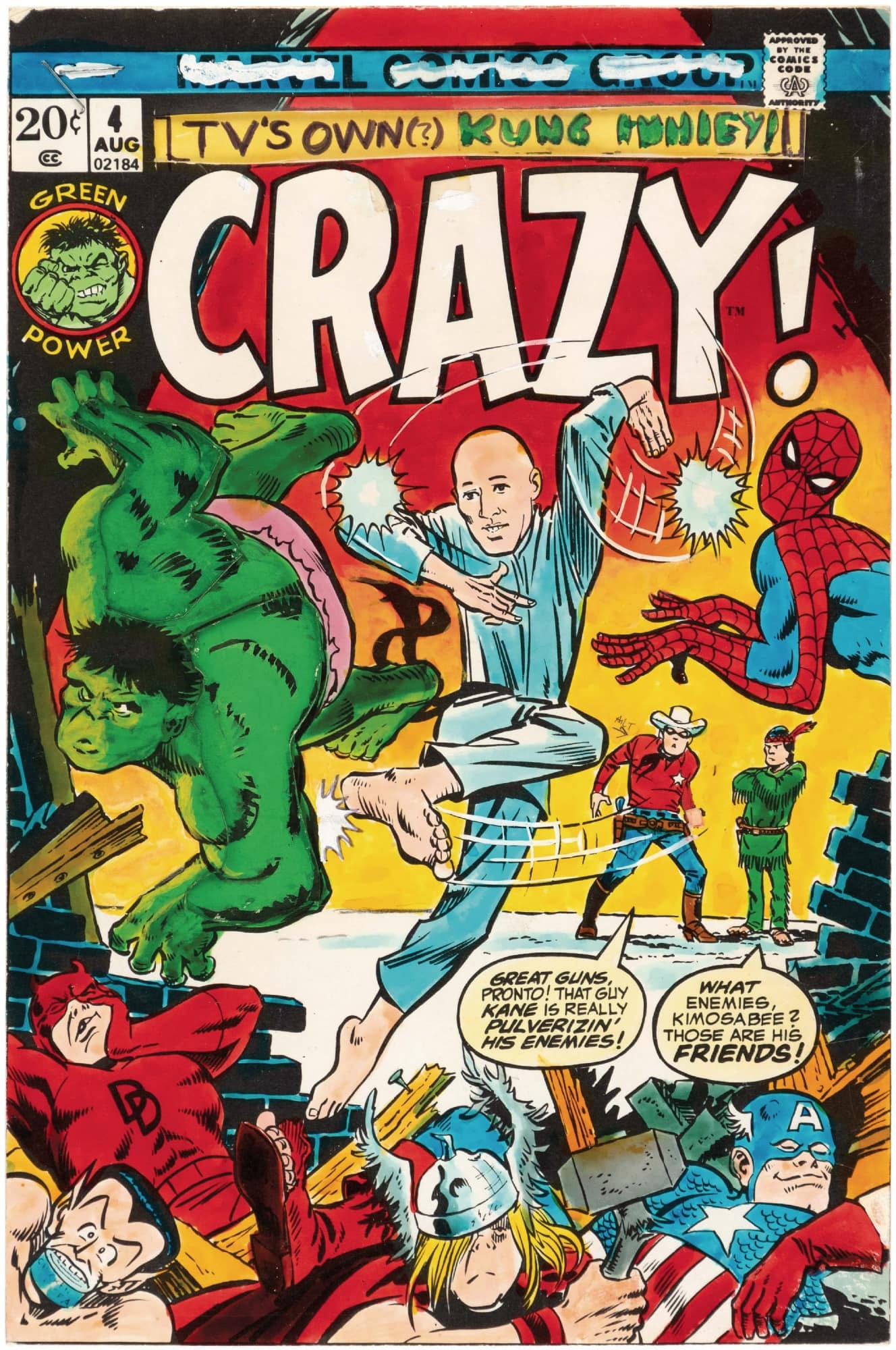

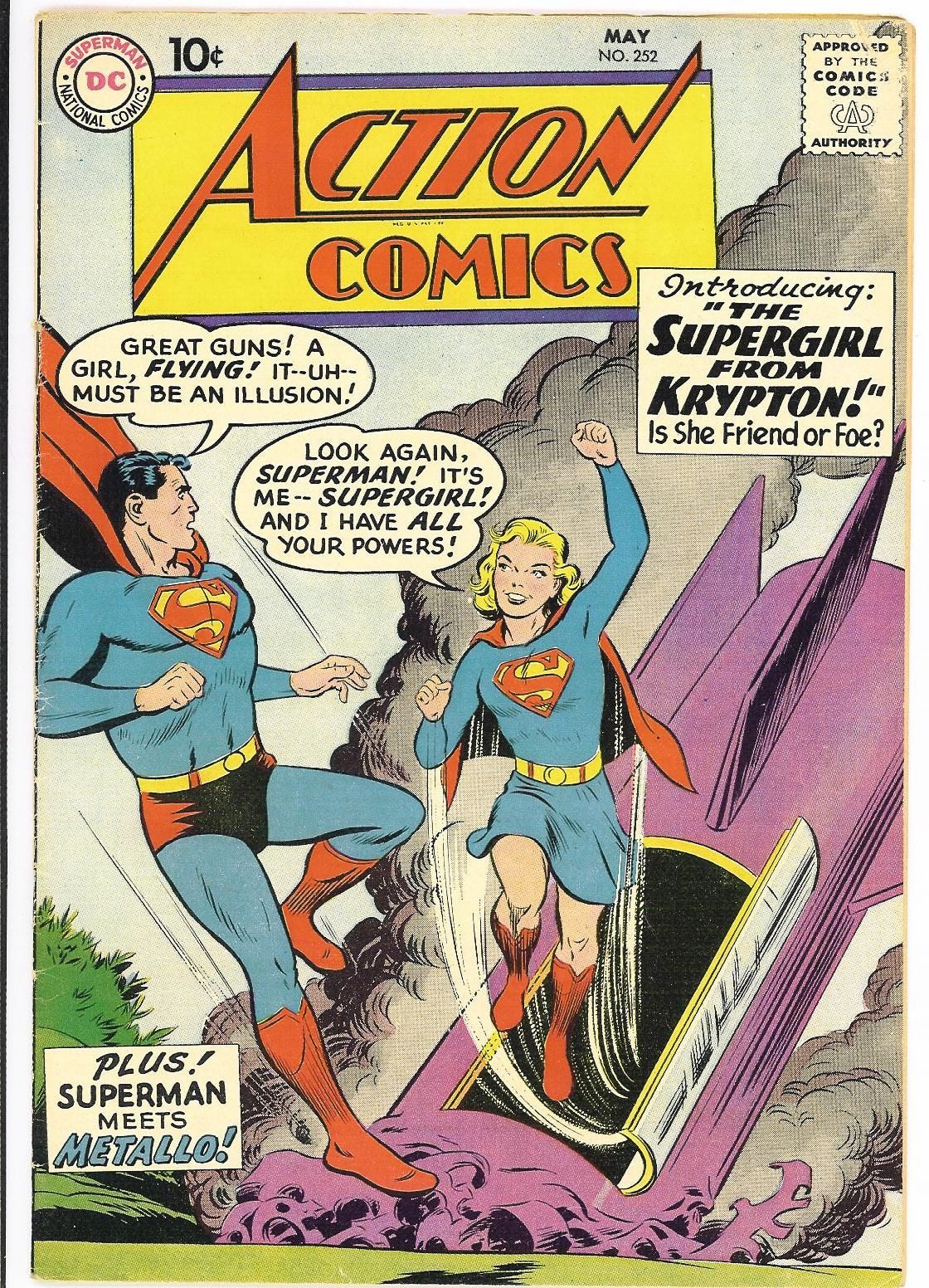
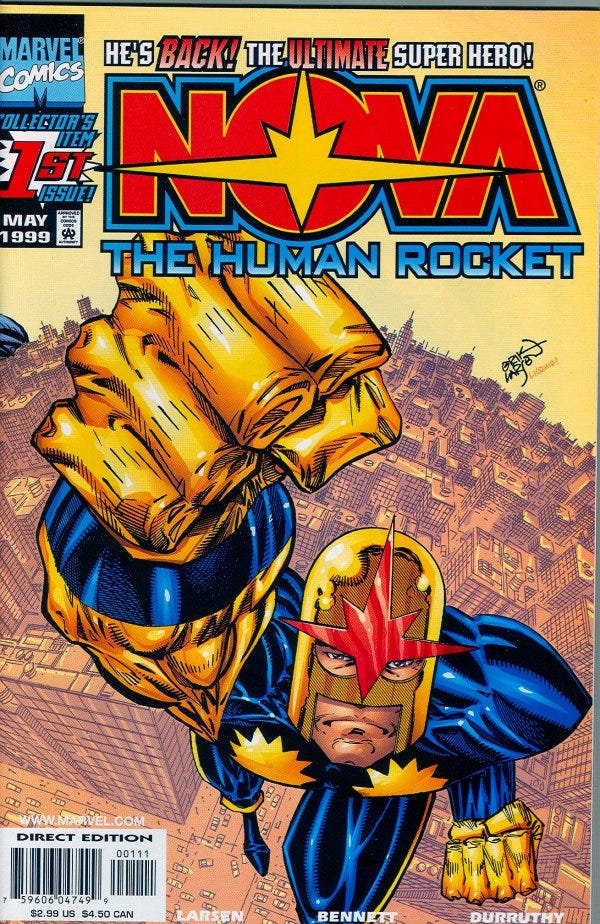
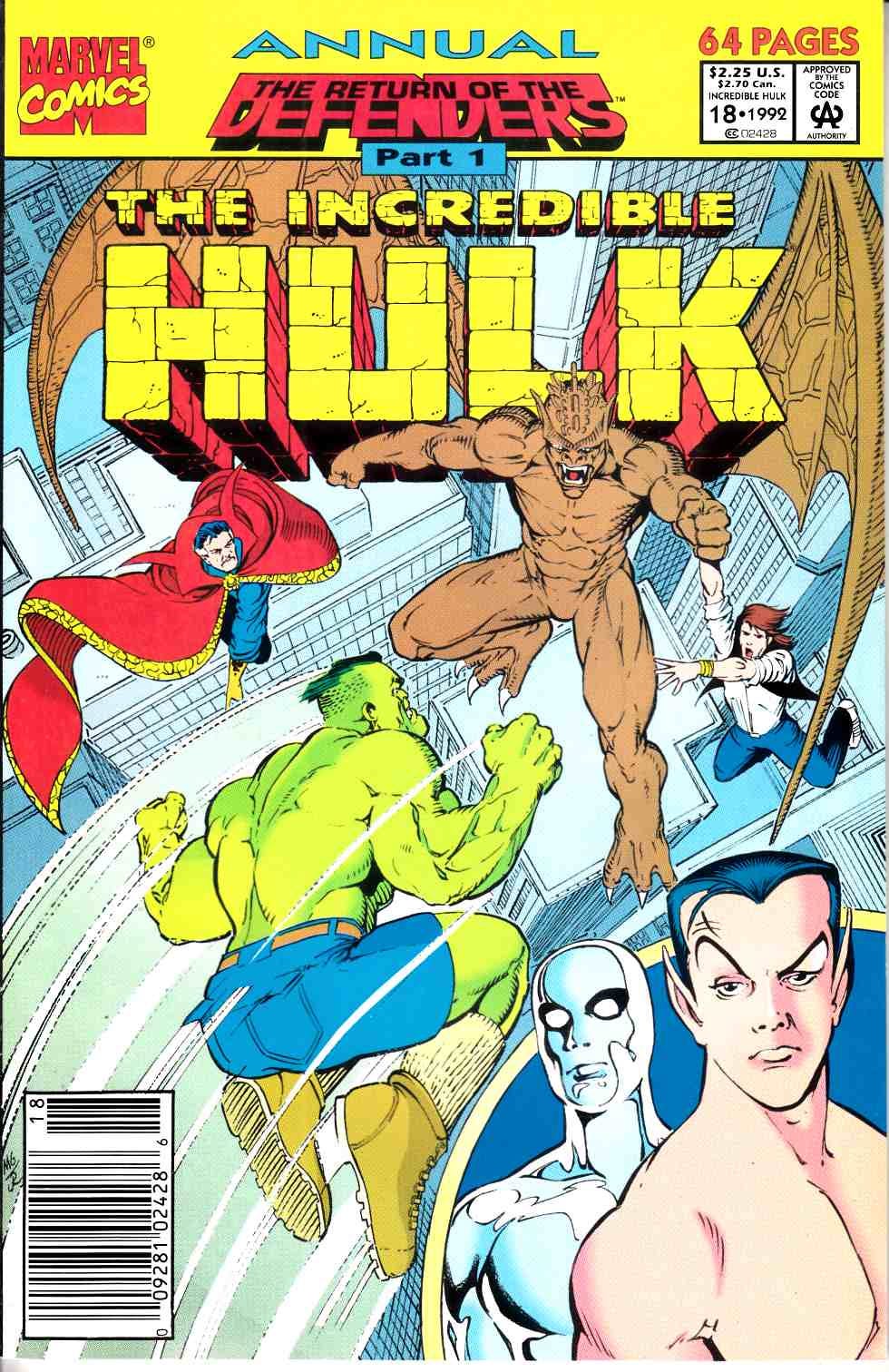
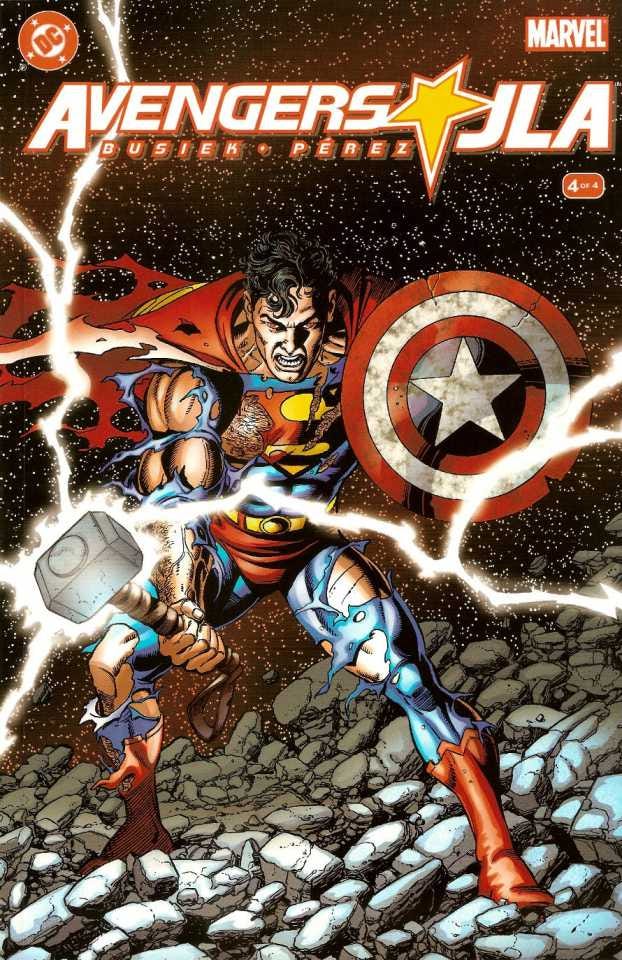
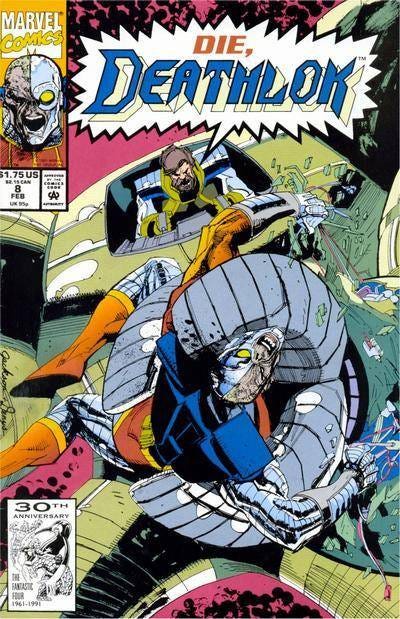
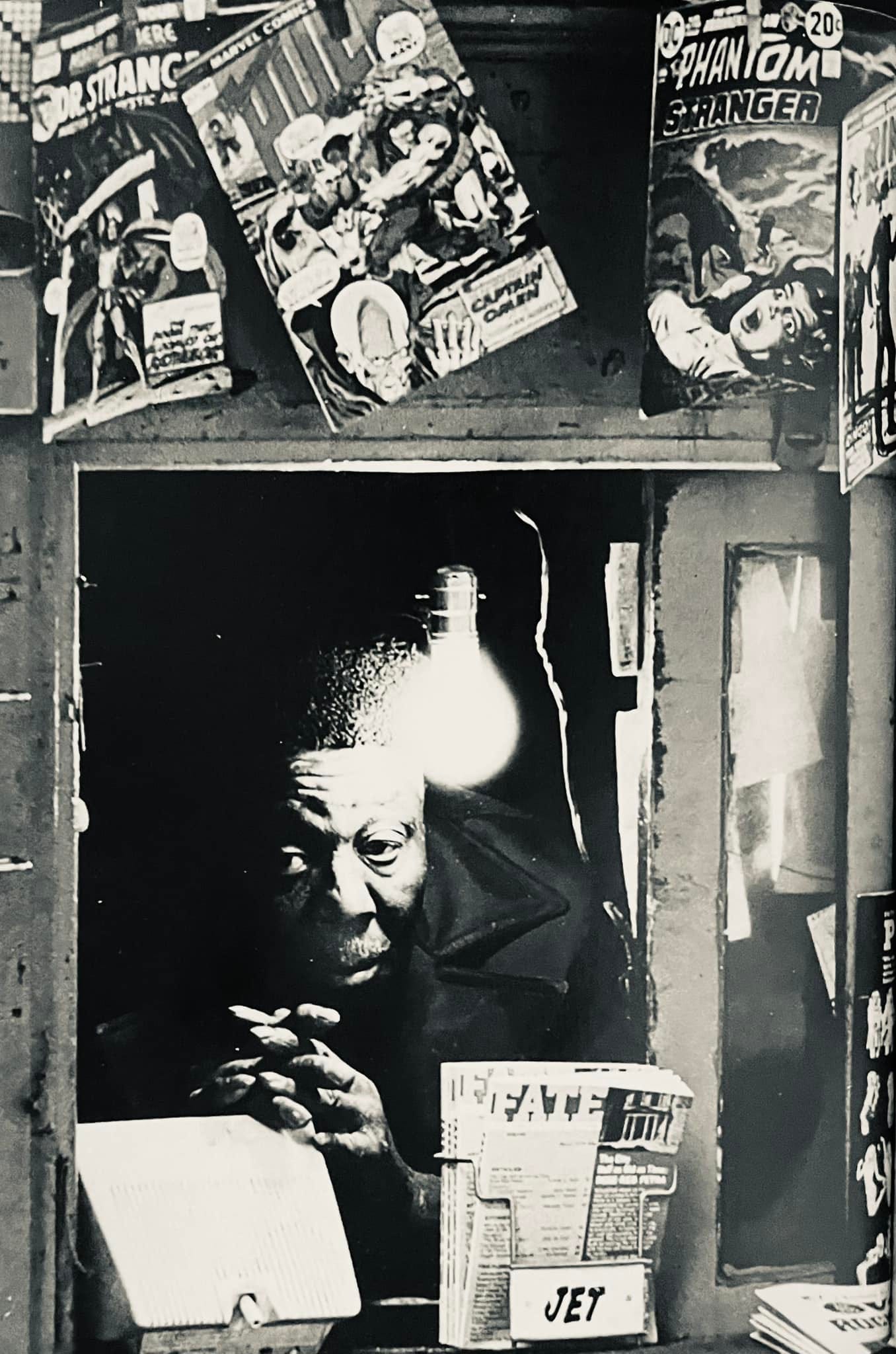
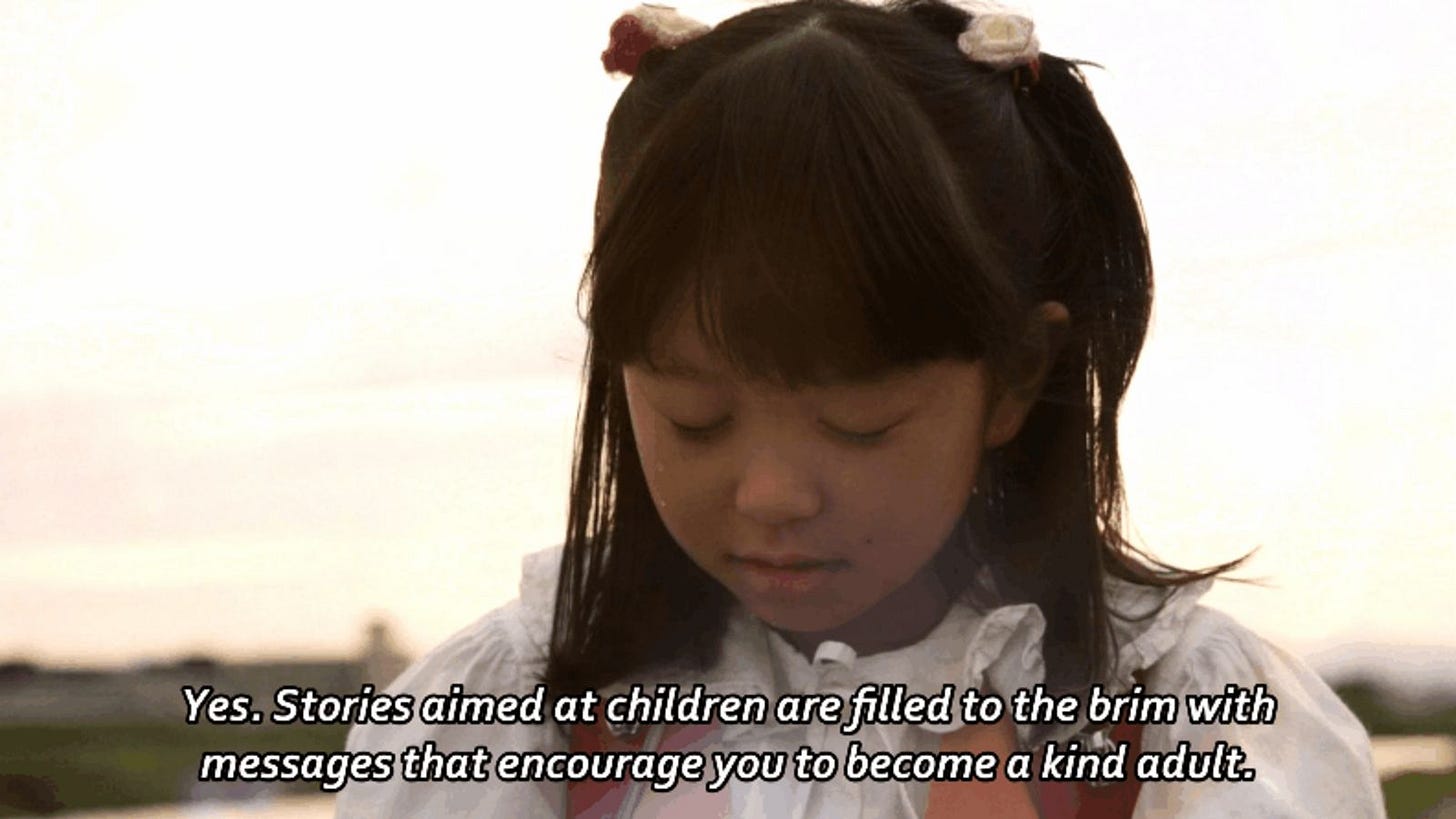
“Though I think ULTIMATE SPIDER-MAN needs more Paul…”
Truly incredible stuff, Tom. I laughed.
I never knew Denys was upset by the Guice cover...I always loved that he inked it! It's on interesting to me that he felt under the shadows of Guice...who ditched us, lol...and Denys SAVED us! This was the first time I got to work with John Hebert, but not the last! Got him some work in the Punisher office with me and did a bunch of coloring jobs over him. We've stayed friends for years and swap all kinds of "stories" not fit for print. Even though it was a "fill-in" issue, I wanted to try to establish our own villains. As it turns out that was really a good fill in to use at this point since we had had so many guest stars. Mainframe was ours, and I had hoped to make Ben Jacob's in his armor something more as well. I do think we should have focused more on creating our own villains and supporting cast.